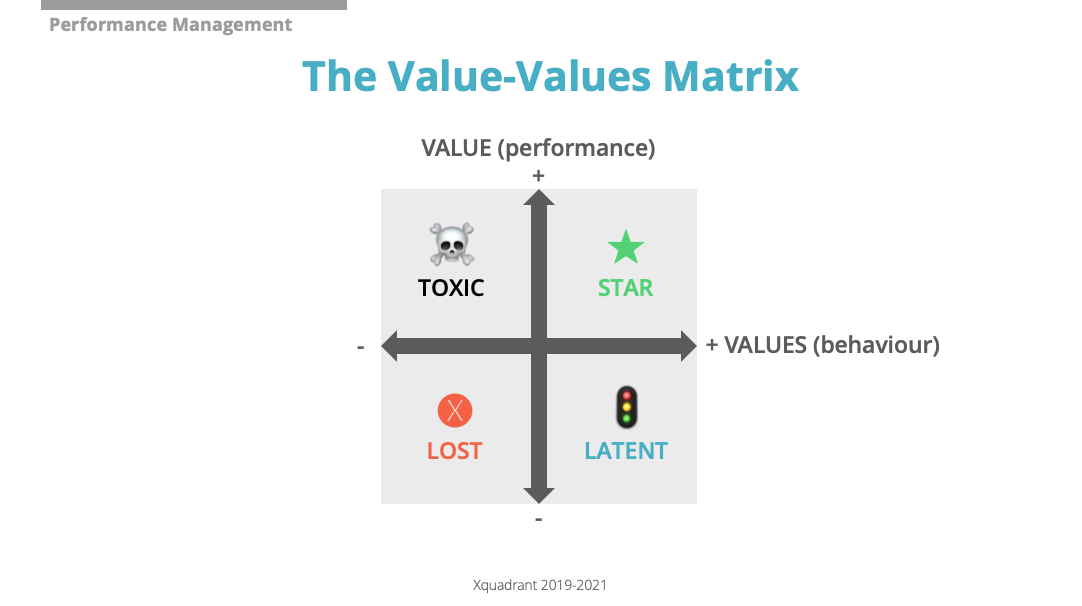Someone on your team is a problem. They’re not pulling their weight, or they are creating collateral damage in the wider organisation due to their inappropriate behaviours. Either way, it’s an unwelcome distraction and the situation poses a risk to your goals and objectives for the business.
How should you handle this situation? Let’s look at the three immediate steps to take.
More...
1. Decide what kind of problem you have
First of all, get clear on the particular issue you have. I find the “Value vs. Values” Matrix helpful here:

Where on this matrix does your employee fall?
there should be a few actions that you can take that will start to create a more conducive environment for the behaviours you’re looking for...
2. Ask yourself the hard questions
It’s very easy to locate the problem in the other person, but accountability is all about taking responsibility for how you create your reality. Don’t play victim (“the other person is a real problem”). Instead, own the situation (“how did I create this dynamic?”). The strength of this way of thinking is that if you contributed to the situation, you can contribute to its solution.
Before moving forward, look in the mirror and identify how you are contributing to the problem. Here’s a checklist of questions you can ask yourself to prompt your thinking.
If there’s a “performance problem”…
- Are the success criteria crystal clear to them?
- How realistic are your expectations? How realistic is your timeline?
- Have I linked the organisational goals and expectations to their own personal goals and aspirations? Can they see what’s in it for them?
- Do they really, truly understand the potential personal consequences of their current underperformance?
- Do they know the very next step they need to take?
- Do they have the time, ability, authority and resources to deliver (in the context of all their other goals and assignments)?
- Is there a training/knowledge gap that can be addressed?
- Have you provided the necessary context to allow them to make good decisions?
- Have you had the hard conversation about the gap between expected and actual performance?
- Are there known consequences for attaining or failing to meet requirements?
- Do you understand this person’s strengths, and are you deploying them wisely?
- Are you creating any distractions or temptations in their environment that are dragging them off course?
If there’s a “behaviour problem”…
- Are your behavioural expectations clearly understood?
- More specifically, are there documented lists of the behaviours of unsuccessful, successful, and star players at the level in question?
- How motivated are they to change? Have you done the job of explaining why their current behaviours will not get them the results they are looking for?
- Do they really, truly understand which specific behaviours you are asking them to change, and what the stakes are for them?
- Do they have a very clear understanding of a specific upcoming ‘moment of truth’ where they will have a chance to choose a different behaviour?
- Are they actually able to do what you are asking, or is there a skills/training gap?
- What behaviour is actually being rewarded within the organisation?
- What is the pay-off they are getting from their current behaviour?
- What behaviour are you modelling to them?
- What is the downside for them if they do actually behave as you desire?
- Are you seeing similar behaviour in other people in the organisation?
If you’ve engaged with these questions thoughtfully, there should be a few actions that you can take that will start to create a more conducive environment for the behaviours you’re looking for.
3. Select the strategy you’ll use
At this point, you need to decide your way forward. There are three basic options:
OPTION 1: TOLERATE the problem employee
You can decide to live with it. Sometimes the negative consequences are minor and it’s simply not worth your effort to resolve the problem.
Toleration is an acceptable solution in some cases. But there’s a real risk of damaging the overall organisation as poor performance or toxic behaviour goes unaddressed. The collateral damage can frustrate the rest of the team, and create a culture where a lack of accountability is assumed.
OPTION 2: TERMINATE the problem employee
You can decide to remove the individual. Many leaders see this as the “simplest option” - but it does come with costs.
Depending on local employment law this can be easier or more difficult, faster or slower, cheaper or more expensive. It might be a quick decision, or involve a complex HR and legal process. Furthermore, this approach can backfire if other employees perceive the termination to be unjust, rushed, or as a consequence of a broader leadership failure within the organisation.
So in any case it’s going to be disruptive. For that reason, I’d advise you to make sure you’ve exhausted other options before taking this path.
OPTION 3: TRANSFORM the problem employee
The third way is to help the person work on the specific behaviours that will move them forward.
This will require some investment: perhaps your time, perhaps the time and expense of hiring an executive coach. In my experience, this approach is quite often overlooked, because the behaviours in question seem ingrained and hard to address.
But the question isn’t, “is this person coachable?” but “is the coach able?”
Putting it another way, you might be telling yourself that this person is a lost cause - they either don’t want to change or they don’t know how to change - but you might just be surprised at how some skilful coaching can help someone develop new strategies to get what they really want (which is rarely being fired or sidelined!). So do make sure that you have access to the necessary skills to make this strategy effective.
At Xquadrant, we use a 6-step process to help individuals identify and overcome the behaviours that are limiting their performance or undermining their impact. I do recommend examining that.
Time and time again we see the power of the TRANSFORM strategy. The employee is validated - the organisation is making an investment in their professional future - and at the same time the challenge is very clearly laid down and accepted before beginning any deeper work. Everyone agrees upfront what success looks like - and the person now has a clear goal to shoot for and a clear game they can win.
The Transform strategy in practice
Results can actually come incredibly quickly. On one occasion I was brought in to work with a C-Suite leader who had been deemed by the incoming CEO as “unfit for the senior team”. The business had already engaged external head-hunters to find his replacement! However, the CEO agreed to give the individual a last chance and engaged me to work with him.
Although it was quite a shock for the leader in question when he understood the stakes, he responded incredibly well to the coaching, going from persona non grata to the CEO’s right hand man in about three months. The reality was that he was an experienced and skilled individual; there were just a couple of behaviours that were letting him down and once he saw the impact of those, correcting them became relatively simple.
What’s your experience of “problem employees” and of applying these three strategies? I’d love to hear your stories.
FREE EMAIL SERIES
Mastering The CEO Learning Curve
No spam. Privacy assured. Unsubscribe anytime.



